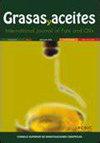植物性脂肪替代猪油的研究进展
IF 1.1
4区 农林科学
Q4 CHEMISTRY, APPLIED
引用次数: 0
摘要
猪油是用作起酥油和油炸介质的主要动物脂肪之一。宗教禁令和对动物脂肪的负面健康观念引起了世界各地社区对猪油消费的担忧。过去,人们进行了各种研究,以配制植物性脂肪和酥油,作为将猪油排除在食物之外的替代品。这最终将有助于各国根据其宗教信仰规范食品配方。由于尚未从自然界中发现单一植物脂肪可以替代猪油,研究人员试图研究将天然脂肪和油(如恩卡邦脂肪、菜籽油、番石榴油、棕榈油、棕榈硬脂、大豆油和可可脂)混合作为原料的可能性。从化学成分和热物理性能方面评估了配方植物性脂肪替代猪油的相容性。配方植物性缩短剂和猪油缩短剂是简单的塑性脂肪,因为它们的稠度值以及β'和β-型多晶型的存在,其中β'型占主导地位。在饼干的配方中,还比较了配方植物性酥油和猪油的功能特性。尽管在过去十年中做了大量工作,但几乎没有讨论过原材料选择方法的利弊以及配方产品评估中采用的标准。因此,本次审查旨在更新这两个方面的研究进展。本文章由计算机程序翻译,如有差异,请以英文原文为准。
Recent advances in plant-based fat formulation as substitute for lard
Lard is one of the main animal fats used as shortening and frying medium. Religious prohibitions and negative health perceptions regarding animal fats have caused concerns about the consumption of lard among communities living around the world. Various research efforts have been made in the past to formulate plant-based fats and shortenings as substitutes for the exclusion of lard from food. This would eventually help countries to regularize food formulations according to their religious compliance. As the existence of a single plant fat as substitute for lard has not been discovered from nature, researchers attempted to study the possibility of mixing native fats and oils such as enkabang fat, canola oil, guava oil, palm oil, palm stearin, soybean oil and cocoa butter as raw materials. The compatibility of the formulated plant-based fat substitute for lard was assessed in terms of chemical composition and thermo-physical properties. The formulated plant-based shortenings and lard shortening were simply plastic fats based on their consistency value and existence of β’ and β-form polymorphs of which the β’ -form was dominant. The functional properties of formulated plant-based shortenings and lard were also compared in the formulation of cookies. Although a substantial amount of work has been done over the past decade, there was hardly any discussion on the pros and cons of the approaches used for raw material selection and the criteria adopted in the assessment of the formulated products. Hence, this review intended to bring an update of the progress of studies with regard to these two aspects.
求助全文
通过发布文献求助,成功后即可免费获取论文全文。
去求助
来源期刊

Grasas y Aceites
工程技术-食品科技
CiteScore
2.50
自引率
0.00%
发文量
50
审稿时长
3 months
期刊介绍:
Grasas y Aceites is a peer-reviewed journal devoted to the publication of original articles concerning the broad field of lipids, especially edible fats and oils from different origins, including non acyl lipids from microbial origin relevant to the food industry. It publishes full research articles, research notes, reviews as well as information on references, patents, and books.
Grasas y Aceites publishes original articles on basic or practical research, as well as review articles on lipid related topics in food science and technology, biology, (bio)chemistry, medical science, nutrition, (bio)technology, processing and engineering. Topics at the interface of basic research and applications are encouraged. Manuscripts related to by-products from the oil industry and the handling and treatment of the wastewaters are also welcomed.
Topics of special interest to Grasas y Aceites are:
-Lipid analysis, including sensory analysis
-Oleochemistry, including lipase modified lipids
-Biochemistry and molecular biology of lipids, including genetically modified oil crops and micro-organisms
-Lipids in health and disease, including functional foods and clinical studies
-Technical aspects of oil extraction and refining
-Processing and storage of oleaginous fruit, especially olive pickling
-Agricultural practices in oil crops, when affecting oil yield or quality
 求助内容:
求助内容: 应助结果提醒方式:
应助结果提醒方式:


